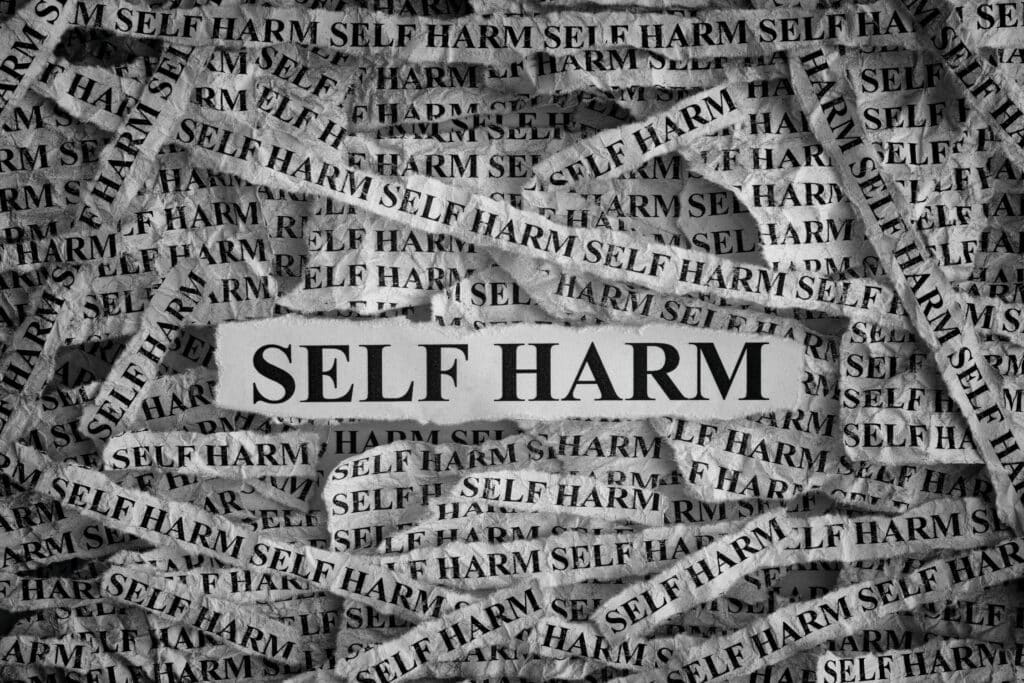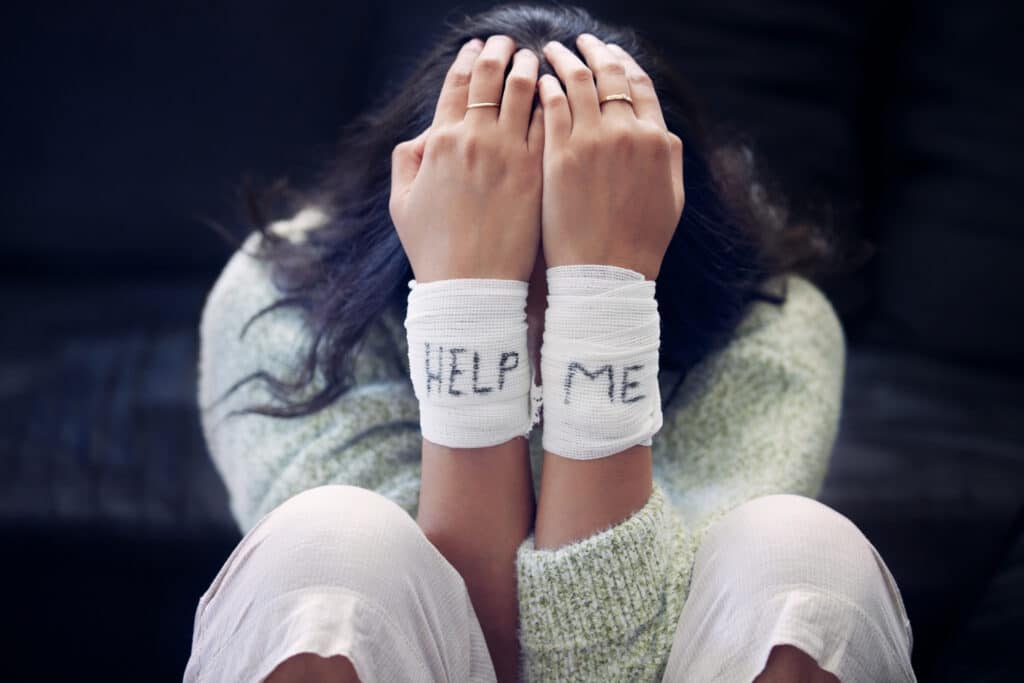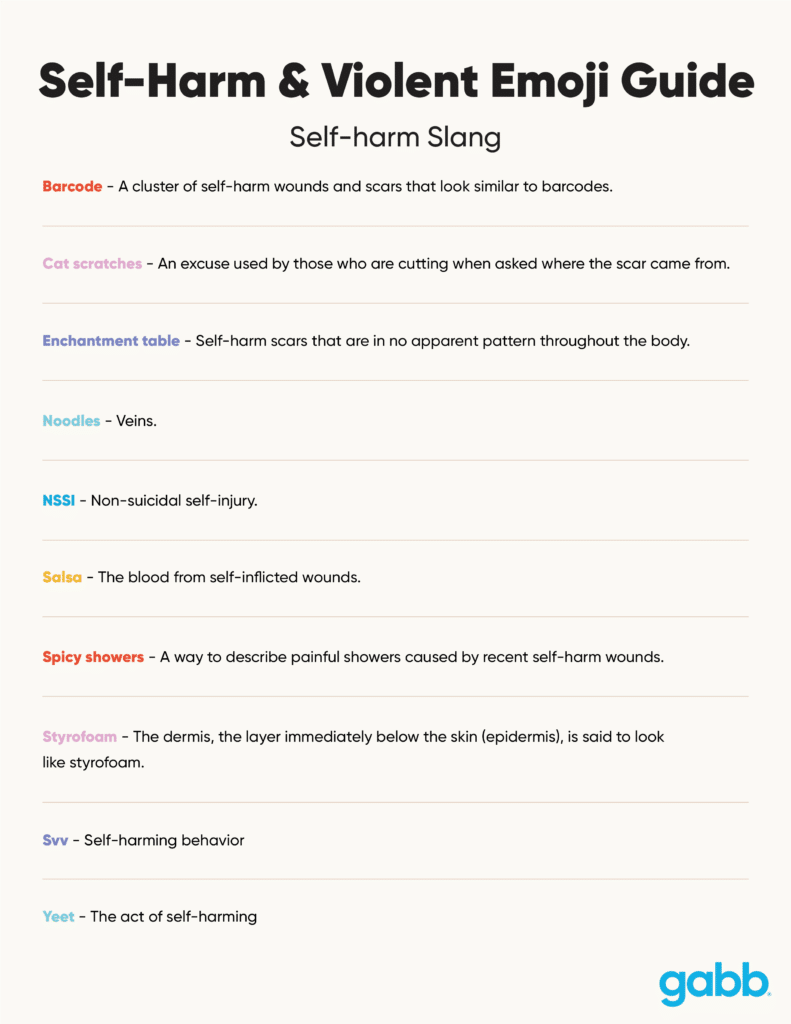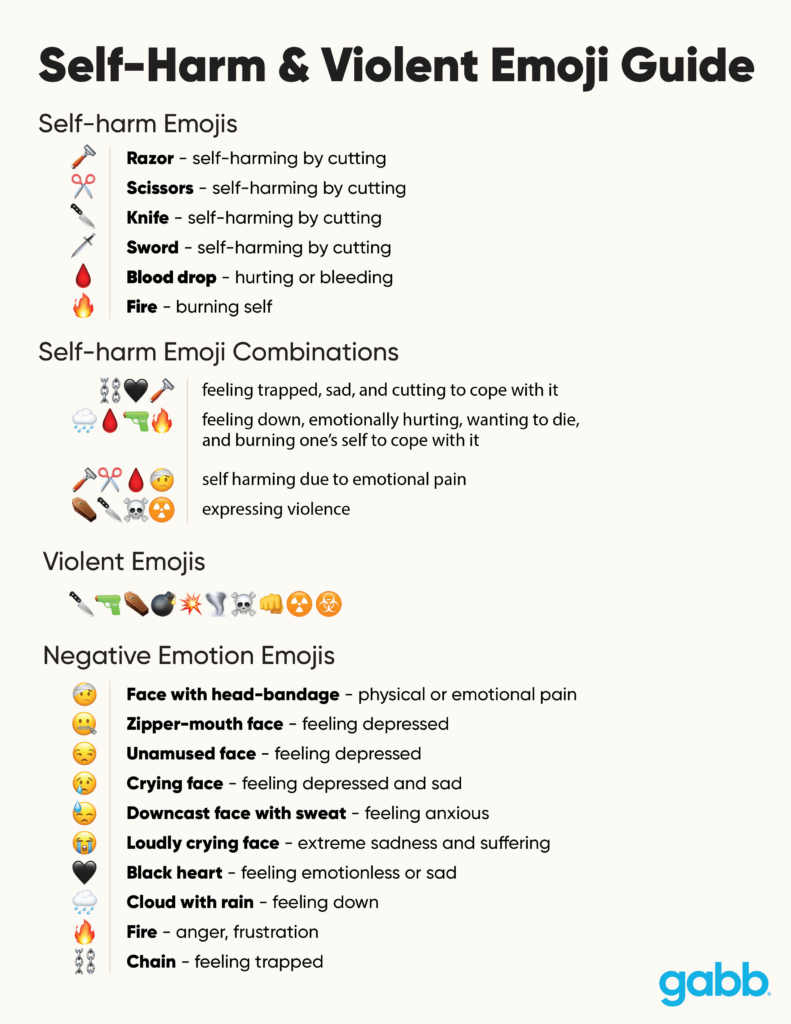In the last several years in the United States, there has been a significant decline in youth mental health and troubling incidences of youth violence.
These adverse childhood experiences are of concern to parents and caregivers, especially during adolescence when teens may begin to pull away and share less.
Understanding how emojis can be used to indicate self-harm and violence may serve as a warning sign that kids are struggling.

What is Self-Harm?
Self-harm refers to the deliberate act of inflicting harm upon oneself as a means of coping with distressing or overpowering emotions and experiences. Kids who engage in self-harming behavior often grapple with intense emotions, and hurting themselves can become a way to manage or express their feelings. Some individuals engage in self-harm to counter feelings of numbness, as the physical pain provides a sensation that helps them feel something.
What Percentage of Kids Self-harm?
The National Institutes of Health conducted a study of 665 youth ages 7-16 and found that 8% had engaged in nonsuicidal self-injury (NSSI). Most at risk are ninth-grade girls, with nearly 1 in 5 reporting self-harm.
How do Kids Self-Harm?
There are various ways kids hurt themselves. Cutting, where sharp objects like razors, knives, and scissors, are used to create small cuts into the skin, is a common way to self-harm.
Some kids resort to burning themselves, biting and scratching their skin, hitting themselves, banging their heads or body against a wall, pulling out hair, eyebrows, or eyelashes, and even inserting objects into their body.
Youth Violence
Federal data highlights the magnitude of youth-perpetrated violence—citing 1 in 5 high school students report physical bullying. And it comes at a cost: 18 billion dollars in combined medical costs and lost productivity each year.
Experts have also concluded that emojis posted on social media by gangs have served to escalate violence by taunting their rivals.

Words and Emojis to be Aware of
There are signs for identifying if a child is potentially self-harming or is threatened with or engaging in violent behavior. Clues can be found in their social media interactions or in text messages.
The Crisis Text Line analyzed over 129 million messages using artificial intelligence, and discovered that those who use the pill emoji (💊) in texts with the hotline were 4.4 times more likely to commit suicide than others. Also, texts containing the loudly crying emoji (😭), and words such as 800mg, acetaminophen, Excedrin, and antifreeze, suggested the sender had a plan to attempt suicide.
Reddit has groups where thousands who are struggling with self-harm share their experiences, slang relating to it, and even wound care tips. If your child has access to this platform, check to see if they are engaging with self-harm subreddits. Self harm information is also found on Pinterest and other social media platforms.
Gabb phones do not provide access to social media to prevent kids from finding self harm information online.
Signs of Self-Harm
Emojis used by kids are open to interpretation and can vary in meaning depending on the context.
While certain emojis may suggest distress or sadness, they can also be used humorously or in non-self-harming contexts. It’s crucial that parents not jump to conclusions upon encountering emojis related to self-harm or violence.
Signs a child may be self-harming
- Physical indicators – Pay attention to unexplained cuts, burns, or bruises, particularly in discrete regions like thighs and wrists.
- Behavioral changes – Take note of significant changes in conduct, such as social withdrawal, avoidance of social interactions, or abrupt mood swings.
- Clothing choices – The child may opt for long sleeves or pants even in warm weather to cover up any self-inflicted injuries.
- Frequent mishaps or alibis – Kids may provide explanations for their injuries that appear implausible or inconsistent.
- Emotional cues – Listen carefully to what the child says, both in-person and online. They may indirectly talk about their struggles or emotional pain.
How Adults Can Help
When we suspect a child may be self-harming, it’s important for us to approach the situation with sensitivity and care. We can communicate openly and express our concern in a non-judgemental way. Kids need to know that adults around them are there to support and love them, no matter what.
We can give our kids the chance to talk and share their feelings while we listen with empathy and seek to understand them.
If at any point you are worried about a child’s safety, it’s imperative to involve your pediatrician or a mental health professional who is experienced in dealing with self-harm issues. Finding the right fit may take a few tries, but it’s important the child likes their therapist so they can feel safe confiding in them and working through emotions. For urgent needs, emergency rooms are equipped to help.
Free resources are available. The national 988 Suicide & Crisis Lifeline provides individuals with 24/7 support via web chat or text.
The Self-Injury Recovery Anonymous group holds weekly virtual meetings where individuals can share experiences, strength, and hope with others who are walking the same path.
Text HOME to 741741 to access help through the Crisis Text Line. Available 24/7, volunteer crisis counselors are just a text away.
Visit our blog for additional resources and help.

Tried and True Ways to Cope with Emotions
Children who self-harm are dealing with painful emotions. In addition to seeking professional help, the following can provide kids with relief from negative feelings.
Mental Health Tips
- Talk to someone – Reaching out and talking about their feelings with another human can help kids cool down and even strategize ways to manage their emotions.
- Get creative – Studies reveal that engaging in art can be a therapeutic way to process emotions.
- Meditate – Researchers have found that mediation is a potent tool to find tranquility.
- Move – Whether it’s going for a walk or exercising, studies consistently show that moving our bodies releases endorphins (the happy hormone).
- Spend time in nature – Fresh air and sunlight can help improve well-being.
- Get enough sleep – Improves mood and reduces stress.
What do you do to help your mental health? Let us know in the comments!











Success!
Your comment has been submitted for review! We will notify you when it has been approved and posted!
Thank you!